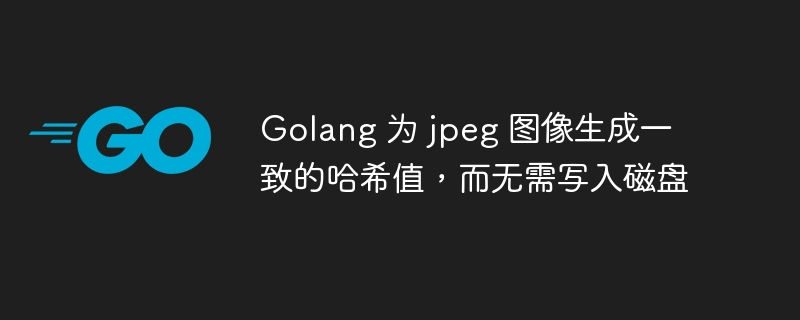Golang 為 jpeg 映像產生一致的雜湊值,而無需寫入磁碟

在開發過程中,我們經常需要比較影像檔案的相似度,以便進行影像辨識、去重等操作。而產生影像的雜湊值是一種常見的方法。通常,我們需要將影像寫入磁碟,然後再讀取出來進行哈希計算。然而,使用Golang程式語言,我們可以輕鬆實現在生成jpeg映像的同時,直接計算一致的雜湊值,而無需寫入磁碟。這為我們節省了時間和磁碟空間,並提高了效率。本文將詳細介紹如何在Golang中實現這項功能。
問題內容
golang 成像新手
我正在嘗試為 jpeg 圖像生成一致的哈希值。 當我以 JPEG 格式寫入磁碟(這是預期的)後重新加載圖像時,加載圖像並在原始位元組上生成哈希值會產生不同的雜湊值。一旦我將 RBGA 作為 JPEG 寫入磁碟,像素就會被修改,這會破壞我之前計算的雜湊值。
僅對檔案 hash("abc.jpeg") 進行雜湊處理就表示我必須寫入磁碟;讀回;產生雜湊值等..
- 在讀取/寫入時是否可以使用任何設定來控制輸出 jpeg 像素的行為
- 我是否應該使用 *image.RGBA?輸入影像是 *image.YCbCr?
// Open the input image file
inputFile, _ := os.Open("a.jpg")
defer inputFile.Close()
// Decode the input image
inputImage, _, _ := image.Decode(inputFile)
// Get the dimensions of the input image
width := inputImage.Bounds().Dx()
height := inputImage.Bounds().Dy()
subWidth := width / 4
subHeight := height / 4
// Create a new image
subImg := image.NewRGBA(image.Rect(0, 0, subWidth, subHeight))
draw.Draw(subImg, subImg.Bounds(), inputImage, image.Point{0, 0}, draw.Src)
// id want the hashes to be the same for read / write but they will always differ
hash1 := sha256.Sum256(imageToBytes(subImg))
fmt.Printf("<---OUT [%s] %x\n", filename, hash1)
jpg, _ := os.Create("mytest.jpg")
_ = jpeg.Encode(jpg, subImg, nil)
jpg.Close()
// upon reading it back in the pixels are ever so slightly diff
f, _ := os.Open("mytest.jpg")
img, _, _ := image.Decode(f)
jpg_input := image.NewRGBA(img.Bounds())
draw.Draw(jpg_input, img.Bounds(), img, image.Point{0, 0}, draw.Src)
hash2 := sha256.Sum256(imageToBytes(jpg_input))
fmt.Printf("--->IN [%s] %x\n", filename, hash2)
// real world use case is..
// generate subtile of large image plus hash
// if hash in a dbase
// pixel walk to see if hash collision occurred
// if pixels are different
// deal with it...
/// else
// object.filename = dbaseb.filename
// else
// add filename to dbase with hash as the lookup
// write to jpeg to disk解決方法
您可以使用雜湊作為編寫器的目標,並使用 io.MultiWriter 在寫入檔案時計算雜湊:
hash:=sha256.New() jpeg.Encode(io.MultiWriter(file,hash),img,nil) hashValue:=hash.Sum(nil)
以上是Golang 為 jpeg 映像產生一致的雜湊值,而無需寫入磁碟的詳細內容。更多資訊請關注PHP中文網其他相關文章!

熱AI工具

Undresser.AI Undress
人工智慧驅動的應用程序,用於創建逼真的裸體照片

AI Clothes Remover
用於從照片中去除衣服的線上人工智慧工具。

Undress AI Tool
免費脫衣圖片

Clothoff.io
AI脫衣器

Video Face Swap
使用我們完全免費的人工智慧換臉工具,輕鬆在任何影片中換臉!

熱門文章

熱工具

記事本++7.3.1
好用且免費的程式碼編輯器

SublimeText3漢化版
中文版,非常好用

禪工作室 13.0.1
強大的PHP整合開發環境

Dreamweaver CS6
視覺化網頁開發工具

SublimeText3 Mac版
神級程式碼編輯軟體(SublimeText3)
 Golang的目的:建立高效且可擴展的系統
Apr 09, 2025 pm 05:17 PM
Golang的目的:建立高效且可擴展的系統
Apr 09, 2025 pm 05:17 PM
Go語言在構建高效且可擴展的系統中表現出色,其優勢包括:1.高性能:編譯成機器碼,運行速度快;2.並發編程:通過goroutines和channels簡化多任務處理;3.簡潔性:語法簡潔,降低學習和維護成本;4.跨平台:支持跨平台編譯,方便部署。
 Golang和C:並發與原始速度
Apr 21, 2025 am 12:16 AM
Golang和C:並發與原始速度
Apr 21, 2025 am 12:16 AM
Golang在並發性上優於C ,而C 在原始速度上優於Golang。 1)Golang通過goroutine和channel實現高效並發,適合處理大量並發任務。 2)C 通過編譯器優化和標準庫,提供接近硬件的高性能,適合需要極致優化的應用。
 Golang vs. Python:主要差異和相似之處
Apr 17, 2025 am 12:15 AM
Golang vs. Python:主要差異和相似之處
Apr 17, 2025 am 12:15 AM
Golang和Python各有优势:Golang适合高性能和并发编程,Python适用于数据科学和Web开发。Golang以其并发模型和高效性能著称,Python则以简洁语法和丰富库生态系统著称。
 Golang vs. Python:性能和可伸縮性
Apr 19, 2025 am 12:18 AM
Golang vs. Python:性能和可伸縮性
Apr 19, 2025 am 12:18 AM
Golang在性能和可擴展性方面優於Python。 1)Golang的編譯型特性和高效並發模型使其在高並發場景下表現出色。 2)Python作為解釋型語言,執行速度較慢,但通過工具如Cython可優化性能。
 Golang的影響:速度,效率和簡單性
Apr 14, 2025 am 12:11 AM
Golang的影響:速度,效率和簡單性
Apr 14, 2025 am 12:11 AM
goimpactsdevelopmentpositationality throughspeed,效率和模擬性。 1)速度:gocompilesquicklyandrunseff,IdealforlargeProjects.2)效率:效率:ITScomprehenSevestAndardArdardArdArdArdArdArdArdArdArdArdArdArdArdArdArdArdArdArdArdArdArdArdArdArdArdArdArdArdArdArdArdArdArdArdArdArdArdEcceSteral Depentencies,增強的Depleflovelmentimency.3)簡單性。
 C和Golang:表演至關重要時
Apr 13, 2025 am 12:11 AM
C和Golang:表演至關重要時
Apr 13, 2025 am 12:11 AM
C 更適合需要直接控制硬件資源和高性能優化的場景,而Golang更適合需要快速開發和高並發處理的場景。 1.C 的優勢在於其接近硬件的特性和高度的優化能力,適合遊戲開發等高性能需求。 2.Golang的優勢在於其簡潔的語法和天然的並發支持,適合高並發服務開發。
 表演競賽:Golang vs.C
Apr 16, 2025 am 12:07 AM
表演競賽:Golang vs.C
Apr 16, 2025 am 12:07 AM
Golang和C 在性能競賽中的表現各有優勢:1)Golang適合高並發和快速開發,2)C 提供更高性能和細粒度控制。選擇應基於項目需求和團隊技術棧。
 Golang和C:性能的權衡
Apr 17, 2025 am 12:18 AM
Golang和C:性能的權衡
Apr 17, 2025 am 12:18 AM
Golang和C 在性能上的差異主要體現在內存管理、編譯優化和運行時效率等方面。 1)Golang的垃圾回收機制方便但可能影響性能,2)C 的手動內存管理和編譯器優化在遞歸計算中表現更為高效。






